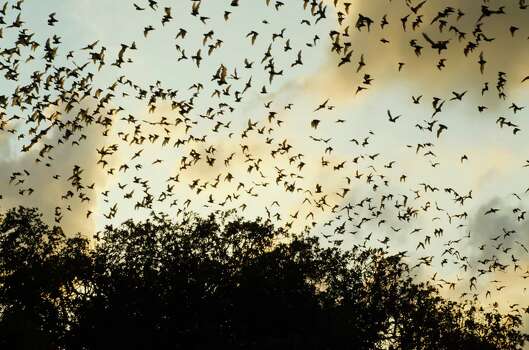Laura Bush, For the Express-News : November 22, 2014 : Updated: November 22, 2014 1:37pm
 |
| Photo By The Nature
Conservancy the Bracken Cave bats. here, bats take off in large numbers from the cave where millions reside each year. |
In June, I had the pleasure of visiting Bracken Cave with Taking Care of Texas, the conservation initiative I founded in 2011, along with our friends from Bat Conservation International. Sitting quietly near the mouth of the cave and watching the ascent of these bats into the clear night sky was a breathtaking experience. I am proud that this internationally renowned site is in our home state. Even bats choose Texas.
Bracken Cave is ranked by Bat Conservation International, the global authority on bats and their conservation, as one of the most important sites for bats in the world. In summer, the colony at Bracken Cave may range from 10 million to 20 million bats.
By comparison, Austin’s famous Congress Avenue Bridge is home to 1.5 million bats, one-tenth the size of the Bracken Cave colony. Bracken Cave’s colony is maternal, meaning the cave is where pregnant females give birth and rear their young.
The bats from Bracken Cave have many important ecological benefits to the Hill Country agriculture and its ecosystem. They consume more than 100 tons of insects nightly.
This unique factor makes Bracken Cave critical to the future of Mexican free-tailed bats and the many plants and animals that depend on their presence in Texas.
Two years ago, more than 1,500 acres adjacent to Bracken Cave were slated for development into a high-density suburban neighborhood with up to four homes per acre. Located in close proximity to the cave and directly under the bats’ nightly flight path, the proposed neighborhood threatened the bat colony’s existence.
That’s why Bat Conservation International launched a campaign last year to purchase the property and leave it intact and protected forever. Taking Care of Texas signed on as an early partner, supporting BCI’s efforts by connecting funding and leadership resources to the campaign and elevating awareness about Bracken Cave.
The Bat Conservation International and the Nature Conservancy announced recently that the property has been officially purchased and put under permanent protection. The city of San Antonio, Bexar County, Edwards Aquifer Authority, Camp Bullis, and many individuals and foundations made this possible. The announcement of this conservation easement is thrilling news.
But the story isn’t over yet. To fully conserve the land around Bracken Cave, Bat Conservation International and The Nature Conservancy must raise the $5 million remaining to pay for the property and its future maintenance.
I invite all Central Texas residents to join BCI and TNC in taking care of the bats at Bracken Cave. By working together to conserve this treasure in Texas, we can protect the land that we leave for our children and generations to come.
To support Bracken Cave, visit www.savethecave.us.
For more information on the cave, visit www.batcon.org/bracken

No comments:
Post a Comment